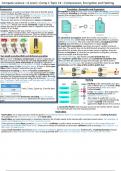Summary
COMPACT SUMMARY FOR TOPIC 14: Compression, Encryption, and Hashing
- Module
- Component 1
- Institution
- OCR
A-Level Computer Science Revision Guide: Compression, Encryption, and Hashing This guide delves into the essential concepts of Compression, Encryption, and Hashing for A-Level Computer Science. It covers Lossy and Lossless Compression techniques, highlighting their applications in reducing fil...
[Show more]



